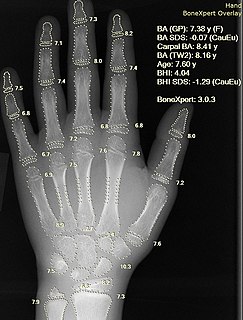Related Research Articles

Pharmacy is the clinical health science that links medical science with chemistry and it is charged with the discovery, production, disposal, safe and effective use, and control of medications and drugs. The practice of pharmacy requires excellent knowledge of drugs, their mechanism of action, side effects, interactions, mobility and toxicity. At the same time, it requires knowledge of treatment and understanding of the pathological process. Some specialties of pharmacists, such as that of clinical pharmacists, require other skills, e.g. knowledge about the acquisition and evaluation of physical and laboratory data.

Health informatics is the field of science and engineering that aims at developing methods and technologies for the acquisition, processing, and study of patient data, which can come from different sources and modalities, such as electronic health records, diagnostic test results, medical scans. The health domain provides an extremely wide variety of problems that can be tackled using computational techniques.

An electronic health record (EHR) is the systematized collection of patient and population electronically stored health information in a digital format. These records can be shared across different health care settings. Records are shared through network-connected, enterprise-wide information systems or other information networks and exchanges. EHRs may include a range of data, including demographics, medical history, medication and allergies, immunization status, laboratory test results, radiology images, vital signs, personal statistics like age and weight, and billing information.

An adverse drug reaction (ADR) is a harmful, unintended result caused by taking medication. ADRs may occur following a single dose or prolonged administration of a drug or result from the combination of two or more drugs. The meaning of this term differs from the term "side effect" because side effects can be beneficial as well as detrimental. The study of ADRs is the concern of the field known as pharmacovigilance. An adverse drug event (ADE) refers to any unexpected and inappropriate occurrence at the time a drug is used, whether or not associated with the administration of the drug. An ADR is a special type of ADE in which a causative relationship can be shown. ADRs are only one type of medication-related harm, as harm can also be caused by omitting to take indicated medications.
An adverse effect is an undesired harmful effect resulting from a medication or other intervention, such as surgery. An adverse effect may be termed a "side effect", when judged to be secondary to a main or therapeutic effect. If it results from an unsuitable or incorrect dosage or procedure, this is called a medical error and not a complication. Adverse effects are sometimes referred to as "iatrogenic" because they are generated by a physician/treatment. Some adverse effects occur only when starting, increasing or discontinuing a treatment. Adverse effects can also be caused by placebo treatments . Using a drug or other medical intervention which is contraindicated may increase the risk of adverse effects. Adverse effects may cause complications of a disease or procedure and negatively affect its prognosis. They may also lead to non-compliance with a treatment regimen. Adverse effects of medical treatment resulted in 142,000 deaths in 2013 up from 94,000 deaths in 1990 globally.
Combination therapy or polytherapy is therapy that uses more than one medication or modality. Typically, the term refers to using multiple therapies to treat a single disease, and often all the therapies are pharmaceutical. 'Pharmaceutical' combination therapy may be achieved by prescribing/administering separate drugs, or, where available, dosage forms that contain more than one active ingredient.
Computerized physician order entry (CPOE), sometimes referred to as computerized provider order entry or computerized provider order management (CPOM), is a process of electronic entry of medical practitioner instructions for the treatment of patients under his or her care.
Pharmacotherapy is therapy using pharmaceutical drugs, as distinguished from therapy using surgery, radiation, movement, or other modes. Among physicians, sometimes the term medical therapy refers specifically to pharmacotherapy as opposed to surgical or other therapy; for example, in oncology, medical oncology is thus distinguished from surgical oncology. Pharmacists are experts in pharmacotherapy and are responsible for ensuring the safe, appropriate, and economical use of pharmaceutical drugs. The skills required to function as a pharmacist require knowledge, training and experience in biomedical, pharmaceutical and clinical sciences. Pharmacology is the science that aims to continually improve pharmacotherapy. The pharmaceutical industry and academia use basic science, applied science, and translational science to create new pharmaceutical drugs.
In medicine, an indication is a valid reason to use a certain test, medication, procedure, or surgery. There can be multiple indications to use a procedure or medication. An indication can commonly be confused with the term diagnosis. A diagnosis is the assessment that a particular [medical] condition is present while an indication is a reason for use. The opposite of an indication is a contraindication, a reason to withhold a certain medical treatment because the risks of treatment clearly outweigh the benefits.
Health is the state of complete physical, mental, and social well-being and a positive concept emphasizing social and personal resources, as well as physical capacities. This article lists major topics related to personal health.
Pharmaceutical care is the direct, responsible provision of medication-related care for the purpose of achieving definite outcomes that improve a patient’s quality of life.
Drug discovery and development requires the integration of multiple scientific and technological disciplines. These include chemistry, biology, pharmacology, pharmaceutical technology and extensive use of information technology. The latter is increasingly recognised as Pharmacoinformatics. Pharmacoinformatics relates to the broader field of bioinformatics.
Health information technology (HIT) is health technology, particularly information technology, applied to health and health care. It supports health information management across computerized systems and the secure exchange of health information between consumers, providers, payers, and quality monitors. Based on an often-cited 2008 report on a small series of studies conducted at four sites that provide ambulatory care – three U.S. medical centers and one in the Netherlands – the use of electronic health records (EHRs) was viewed as the most promising tool for improving the overall quality, safety and efficiency of the health delivery system.
Drug therapy problems (DTPs) represent the categorization and definition of clinical problems related to the use of medications or "drugs" in the field of pharmaceutical care. In the course of clinical practice, DTPs are often identified, prevented, and/or resolved by pharmacists in the course of medication therapy management, as experts on the safety and efficacy of medications, but other healthcare professionals may also manage DTPs.
ICU Medical, Inc. is a San Clemente, California-based company with global operations that develops, manufactures, and sells medical technologies used in vascular therapy, oncology, and critical care applications.
Fast Healthcare Interoperability Resources is a standard describing data formats and elements and an application programming interface (API) for exchanging electronic health records (EHR). The standard was created by the Health Level Seven International (HL7) health-care standards organization.
Joseph Antony Cafazzo is a Canadian biomedical engineer, educator, and researcher.
Specialty drugs or specialty pharmaceuticals are a recent designation of pharmaceuticals that are classified as high-cost, high complexity and/or high touch. Specialty drugs are often biologics—"drugs derived from living cells" that are injectable or infused. They are used to treat complex or rare chronic conditions such as cancer, rheumatoid arthritis, hemophilia, H.I.V. psoriasis, inflammatory bowel disease and hepatitis C. In 1990 there were 10 specialty drugs on the market, in the mid-1990s there were fewer than 30, by 2008 there were 200, and by 2015 there were 300. Drugs are often defined as specialty because their price is much higher than that of non-specialty drugs. Medicare defines any drug for which the negotiated price is $670 per month or more, as a specialty drug which is placed in a specialty tier that requires a higher patient cost sharing. Drugs are also identified as specialty when there is a special handling requirement or the drug is only available via a limited distributions network. By 2015 "specialty medications accounted for one-third of all spending on drugs in the United States, up from 19 percent in 2004 and heading toward 50 percent in the next 10 years", according to IMS Health, which tracks prescriptions. According to a 2010 article in Forbes, specialty drugs for rare diseases became more expensive "than anyone imagined" and their success came "at a time when the traditional drug business of selling medicines to the masses" was "in decline". In 2015 analysis by The Wall Street Journal suggested the large premium was due to the perceived value of rare disease treatments which usually are very expensive when compared to treatments for more common diseases.

Artificial intelligence in healthcare is an overarching term used to describe the use of machine-learning algorithms and software, or artificial intelligence (AI), to mimic human cognition in the analysis, presentation, and comprehension of complex medical and health care data. Specifically, AI is the ability of computer algorithms to approximate conclusions based solely on input data.
IBM Watson Health is a digital tool that helps clients facilitate medical research, clinical research, and healthcare services, through the use of artificial intelligence, data, analytics, cloud computing, and other advanced information technology. It is a division of the International Business Machines Corporation, (IBM), an American multinational information technology company headquartered in Armonk, New York.
References
- 1 2 3 4 5 Yap, KY; Chuang, X; Lee, AJM; Lee, RZ; Lim, L; Lim, JJ; Nimesha, R (2009). "Pharmaco-cybernetics as an interactive component of pharma-culture: empowering drug knowledge through user-, experience- and activity-centered designs". International Journal of Computer Science Issues. 3: 1–13.
- ↑ Stedman TL. Stedman's Medical Dictionary. 28th ed. Baltimore, Maryland: Lippincott Williams & Wilkins; 2005.
- 1 2 Pangaro P. "Getting started" guide to cybernetics. Available at: http://pangaro.com/published/cyber-macmillan.html.
- 1 2 American Society for Cybernetics. Foundations - the subject of cybernetics: defining 'cybernetics'. Available at: http://www.asc-cybernetics.org/foundations/definitions.htm.
- ↑ Corning, PA (1996). "Synergy, cybernetics, and the evolution of politics". International Political Science Review. 17 (1): 91–119. doi:10.1177/019251296017001006. S2CID 143822151.
- ↑ Geyer, F (1995). "The challenge of sociocybernetics". Kybernetes: The International Journal of Systems & Cybernetics. 24 (4): 6–32. doi:10.1108/03684929510089321.
- ↑ Adams, PC (1997). "Cyberspace and virtual places". Geographical Review. 87 (2): 155–171. doi:10.2307/216003. JSTOR 216003.
- ↑ Trappl R. The cybernetics and systems revival: Paper presented at: 14th European Meeting on Cybernetics and Systems Research (EMCSR'98); 14–17 April 1998; University of Vienna, Austrian Society for Cybernetic Studies.
- ↑ Gibson W. Neuromancer (Special 20th Anniversary Edition). Hardcover ed: Ace Books; 2004.
- 1 2 Yap, KY; Chan, A; Chui, WK (2009). "Improving pharmaceutical care in oncology by pharmacoinformatics: the evolving role of informatics and the internet for drug therapy". Lancet Oncology. 10 (10): 1011–1019. doi:10.1016/S1470-2045(09)70104-4. PMID 19796753.
- 1 2 "ASHP statement on pharmaceutical care". American Journal of Hospital Pharmacy. 50 (8): 1720–1723. 1993. doi:10.1093/ajhp/50.8.1720.
- ↑ Pharmaceutical Care Network Europe. PCNE classification for drug-related problems v6.2. Available at: http://www.pcne.org/sig/drp/documents/PCNE%20classification%20V6-2.pdf.
- ↑ Paquette D, Ryan J. Bronfenbrenner’s Ecological Systems Theory. Available at: "Archived copy" (PDF). Archived from the original (PDF) on 2007-09-28. Retrieved 2007-09-28.
{{cite web}}: CS1 maint: archived copy as title (link). - ↑ Yap, KY; Lim, KJ (2012). "Merging the old with the new: a cybermedicine marriage for oncology interactions with traditional herbal therapies and complementary medicines". Tang - International Journal of Genuine Traditional Medicine. 2 (2): e18. doi: 10.5667/tang.2012.0004 .
- ↑ Chan, A; Yap, KY (2010). "Detection and management of oncology drug interactions: Can we do better?". Maturitas. 65 (3): 181–182. doi:10.1016/j.maturitas.2009.12.001. PMID 20036470.